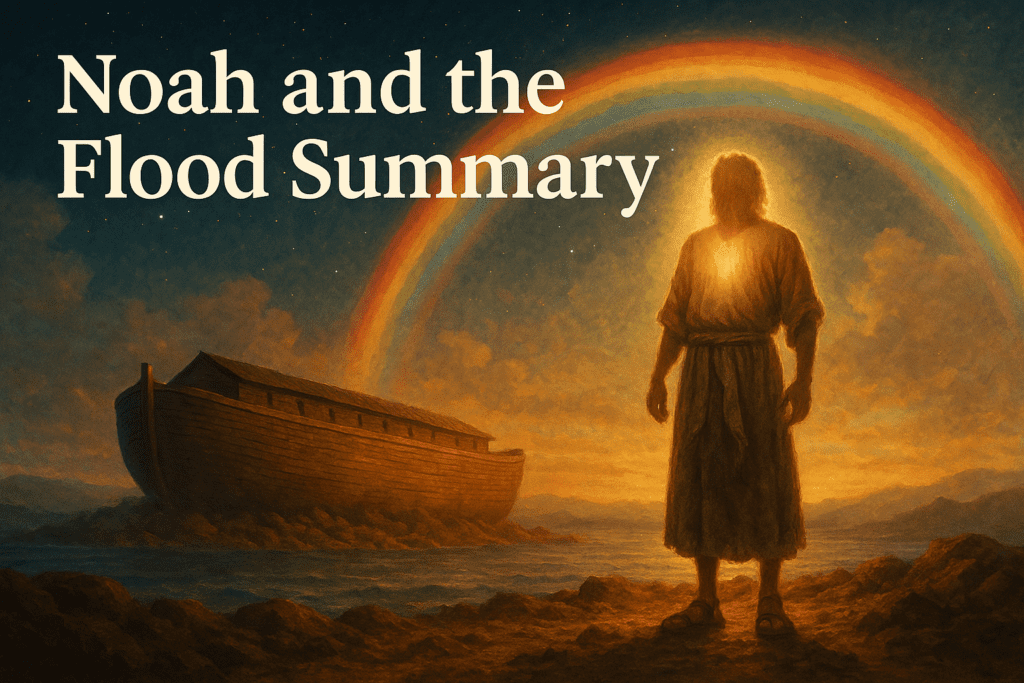Intro: Noah and the Flood Summary
Genesis chapters 8–9 mark a pivotal moment in the Bible’s story of redemption. This Noah and the Flood Summary captures the unfolding of mercy, judgment, and renewal as seen through the lens of God’s covenant with Noah. They follow the worldwide flood that reset creation, preserve God’s faithful remnant, and establish a covenant of mercy that stretches into our day, and this Noah and the Flood Summary highlights each detail through a prophetic and theological lens. Here’s a summary of the key points and themes: This Noah and the Flood Summary breaks them down one by one.
1. The Global Flood Ends – Noah and His Sons Survive
- The flood had destroyed all land-dwelling life except for Noah, his three sons, and their families.
- They alone survived inside the ark, which rested on the mountains of Ararat.
2. God Was Grieved by Humanity’s Evil
- God saw that every inclination of man’s heart was evil continually (Genesis 6:5).
- The Sons of God (descendants of Seth) were dwindling in number and influence.
- Only Noah walked with God and was found righteous in his generation.
3. The Intermingling of Seth’s Line and Cain’s Line
- The Sons of God intermarried with the daughters of men, corrupting the line.
- This produced men of great renown—heroes by earthly standards, but not righteous.
- Violence, sin, and self-glorifying culture increased, just as it is foretold to happen again in the end times.
4. Noah and His Family Were the Last of the Uncorrupted Line
- God preserved only Noah, his wife, his sons, and their wives—eight people in all.
- These were likely the last fully faithful descendants of Seth who had not intermingled with the corrupted lines developing in the world. This ensured that the redemptive line leading to Jesus remained distinct and uncorrupted, preserving God’s promise through a faithful lineage. This ensured that the redemptive line leading to Jesus remained distinct and uncorrupted, preserving God’s promise through a faithful lineage.
5. Noah Builds the Ark
- God instructs Noah to build an ark according to exact specifications.
- Noah obeys without hesitation and prepares as God commands.
6. Introduction of Clean and Unclean Animals
- First biblical mention of “clean” and “unclean” animals (Genesis 7:2–3).
- Clean animals were loaded in sevens; unclean in twos.
- This distinction anticipates later Levitical laws.
7. Symbolic Numbers in the Story
- 7: Days of waiting, pairs of clean animals, days between bird releases—symbolizing completion and spiritual order.
- 40: Days of rain—symbolizing testing and judgment.
- 370 days total in the ark—symbolizing a full cycle of judgment and renewal.
- 17th day of the 7th month: When the ark rested—some see this as a symbol of resurrection and rest.
8. The Covenant God Gave After the Flood
God made several promises to Noah and all creation:
- Never again would a flood destroy all life (Genesis 9:11).
- The rainbow would be the sign of this everlasting covenant (Genesis 9:13–17).
- Lifeblood must not be consumed—God established the sacredness of life (Genesis 9:4).
- Human life is accountable—“Whoever sheds blood, by man shall his blood be shed” (Genesis 9:6).
- Be fruitful and multiply—a re-commissioning of humanity (Genesis 9:1).
- The seasons and cycles of the earth would remain as long as the world endures (Genesis 8:22).
9. The Curse on the Ground Was Lifted Through Noah
- Genesis 5:29 – Lamech named him “Noah” saying, “He will comfort us in the labor and painful toil of our hands caused by the ground the Lord has cursed.”
- Genesis 8:21 – After Noah’s offering, God says: “Never again will I curse the ground because of humans…”
- This moment marks a reversal of the curse from Genesis 3.
10. The Future of Noah’s Sons
- Shem is blessed and becomes the ancestor of Abraham and the priestly line.
- Ham’s son Canaan is cursed for dishonoring Noah.
- Japheth is blessed with expansion and is prophesied to dwell in the tents of Shem (Genesis 9:27), a hint that Japheth would one day assume the position or adopt the identity associated with Shem’s line—sharing in its covenant blessings and perhaps even being seen as its spiritual or cultural successor in later generations.
11. The Nephilim Will Reappear
- Though the flood wiped them out, the Nephilim (giants/warriors) are said to reappear.
- Genesis 6:4 says, “The Nephilim were on the earth in those days—and also afterward”—implying that their legacy or offspring would persist even beyond the flood.
- The intermixing of faithful and unfaithful lines (as with Canaan) allows the pattern to repeat.
12. Shem as Priest: Melchizedek Connection
- Shem’s line is preserved in Scripture.
- Many scholars and early Jewish sources identify Shem with Melchizedek, the mysterious priest-king of Salem who blesses Abraham in Genesis 14.
- This links Noah’s son Shem directly to the priesthood and ultimately to Jesus, who is called a priest forever in the order of Melchizedek (Psalm 110:4; Hebrews 7).
This Noah and the Flood Summary shows that Genesis 8–9 is not just about survival—it’s about mercy, renewal, priesthood, and prophecy. From Noah’s altar to the rainbow in the sky, this Noah and the Flood Summary explores how every detail whispers of the Savior who would come to bring final comfort and rest.
For further insight into how Jesus fulfilled the moral and prophetic foundation of the patriarchs, visit our article on The Sermon on the Mount.
For historical background on this event, see Genesis on Wikipedia. Some critics claim Genesis was shaped by later editors, but the prophetic harmony—from Noah to Christ—is too precise to be coincidence. Moses wrote a divinely inspired book, guided by truths only the Author of history could reveal.
